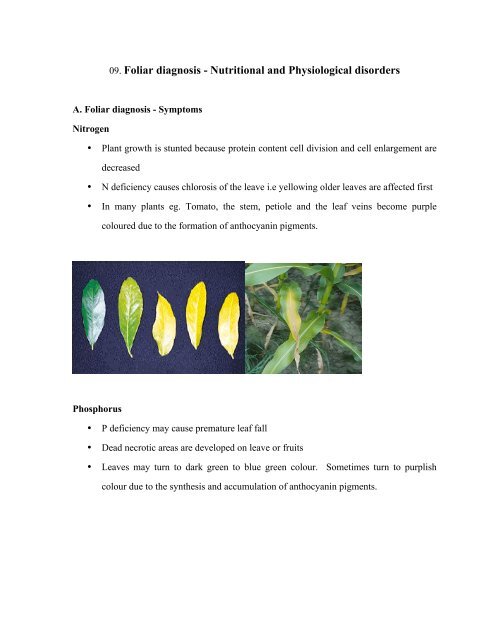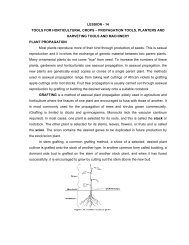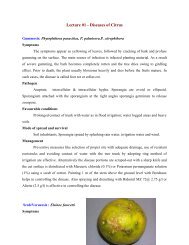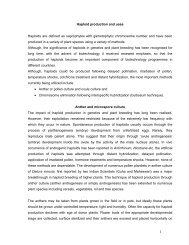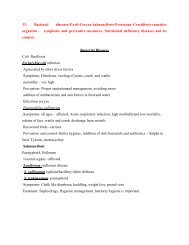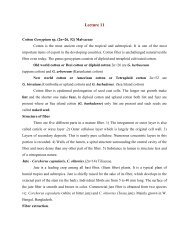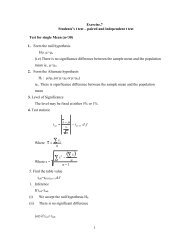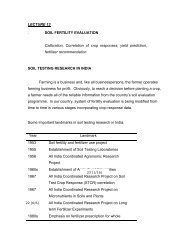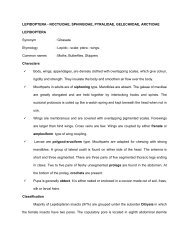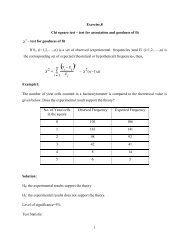Create successful ePaper yourself
Turn your PDF publications into a flip-book with our unique Google optimized e-Paper software.
<strong>09</strong>. <strong>Foliar</strong> <strong>diagnosis</strong> - Nutritional and Physiological disordersA. <strong>Foliar</strong> <strong>diagnosis</strong> - SymptomsNitrogen• Plant growth is stunted because protein content cell division and cell enlargement aredecreased• N deficiency causes chlorosis of the leave i.e yellowing older leaves are affected first• In many plants eg. Tomato, the stem, petiole and the leaf veins become purplecoloured due to the formation of anthocyanin pigments.Phosphorus• P deficiency may cause premature leaf fall• Dead necrotic areas are developed on leave or fruits• Leaves may turn to dark green to blue green colour. Sometimes turn to purplishcolour due to the synthesis and accumulation of anthocyanin pigments.
Potassium• Mottled chlorosis of leaves occurs• Neurotic areas develop at the tip and margins of the leaf• Plants growth remains stunted with shortening of internodes.Calcium• Calcium deficiency causes disintegration of growing meristematic regions of root,stem and leaves• Chlorosis occurs along the margins of the younger leaves
MicronutrientsIronIron deficiency causes chlorosis of young leaves which is usually interveinal.
Zinc• Zinc deficiency causes chlorosis of the young leaves which starts from tips and themargins• The size of the young leaves is very much reduced. This disorder is called as ‘littleleaf disease’• Stalks will be very short.
Manganese• The young leaves are affected by mottled chlorosis• Veins remain green• Small necrotic spots developed on the leaves with yellow stripsCopper• Copper deficiency causes necrosis of the tip of the young leaves• It also causes die-back of citrus and fruit trees• Also causes reclamation disease or white tip disease of cereals and leguminous plants.
Boron• Boron deficiency causes death of shoot tip• Flower formation is suppressed• Root growth is stunted• The other diseases caused by B deficiency is• Heart rot of beet• Stem crack of celery• Brown heart of cabbage• Water core of turnip• Internal cork formation in apple• Hen and chicken in grapes
Molybdenum• Molybdenum deficiency causes interveinal chlorosis of older leaves• Flower formation is inhibited• Causes whiptail disease in cauliflower plants.
<strong>Foliar</strong> Nutrition<strong>Foliar</strong> nutrition is fertilizing certain crop plants through aerial spraying.MechanismPenetration of the spray solution or nutrient solution occurs through cuticle the layerof polymerized wax which occurs on outer surface of the epidermal cells of leaves. Afterpenetration in the cuticle, further penetration take place through fine, thread like semimicroscopicstructure called ectodesmata. This extends through the outer epidermal cellwall, from the inner surface of the cuticle to the plasma membrane. When the substancereaches plasma membrane of an epidermal cell, it will be observed by mechanism similar tothose which operate in root cells.1. <strong>Foliar</strong> nutrition may serve as a mean of applying supplemental macronutrients duringcritical growth periods when it is impracticable to apply fertilizers to soil. Eg.Unusual period of dry weather.2. <strong>Foliar</strong> nutrition may afford a remedy for the time lag between soil applied and plantabsorbed. Time is too long because of fast growing rates.NUTRITIONAL DISORDERSWhen a nutrient element insufficiency (deficiency and/or toxicity) occurs, visualsymptoms may or may not appear, although normal plant development will be slowed. Whenvisual symptoms do occur, such symptoms can frequently be used to identify the source ofthe insufficiency.Deficiency Symptoms• Stunted or reduced growth of the entire plant with the plant itself either remaininggreen or lacking an over-all green color with either the older or younger leaves beinglight green to yellow in color.• Chlorosis of leaves, either interveinal or of the whole leaf itself, with symptoms eitheron the younger and/or older leaves, or both (chlorosis due to the loss or lack ofchlorophyll production).
• Necrosis or death of a portion (margins or interveinal areas) of a leaf, or the wholeleaf, usually occurring on the older leaves.• Slow or stunted growth of terminals (rosetting), the lack of terminal growth, or deathof the terminal portions of the plant.• A reddish purpling of leaves, frequently more intense on the under side of olderleaves due to the accumulation of anthocyanin (Mottling)Chlorosis is caused by the deficiency of mineral elements such as Mn, K, Zn, Fe, Mg, S andN. Mottling is caused due to the deficiencies of N, Mg, P, S and Necrosis due to thedeficiency of Mg, K, Zn, Ca and Mo.Toxicity SymptomsVisual symptoms of toxicity may not always be the direct effect of the element inexcess on the plant, but the effect of the excess element on one or more other elements. Forexample, an excessive level of potassium (K) in the plant can result in either magnesium(Mg) and/or calcium (Ca) deficiency, excess phosphorus (P) can result in a zinc (Zn)deficiency and excess Zn in an iron (Fe) deficiency.These effects would compare to elements, such as boron (B), chlorine (Cl), copper(Cu), and manganese (Mn), which create visual symptoms that are the direct effect of anexcess of that element present in the plant.Some elements, such as aluminum (Al) and copper (Cu) can affect plant growth anddevelopment due to their toxic effect on root development and function.Hidden HungerIn some instances, a nutrient element insufficiency may be such that no symptoms ofstress will visually appear with the plant seeming to be developing normally. This conditionhas been named hidden hunger, a condition that can be uncovered by means of either a plantanalysis and/or tissue test.A hidden hunger occurrence frequently affects the final yield and the quality of theproduct produced. For grain crops, the grain yield and quality may be less than expected; forfruit crops, abnormalities, such as blossomed rot and internal abnormalities may occur, andthe post harvest characteristics of fruits and flowers will result in poor shipping quality and
educed longevity. Another example is potassium (K) insufficiency in corn, a - deficiencythat is not evident until at maturity when plants easilyPHYSIOLOGICAL DISORDERSPhysiological disorder is the abnormal growth pattern or abnormal external or internalconditions of fruits due to adverse environmental conditions such as deviation from normalstate of temperature, light, moisture, nutrient, harmful gases and inadequate supply of growthregulators.Disorders associated with low temperature1. Leaf chlorosis and frost bandingChlorosis was caused by a disruption of chloroplasts caused by winter cold. Greenchlorophyll pigments are often converted in to yellow pigment. Leaf may appear with distinctbleached bands across the blade of young plants called frost banding e.g.: sugarcane, wheatand barley.2. Leaf necrosis and malformationsSpring frost causes various types and degree of injury including cupping, crinklingfinishing and curling of leaves of apple trees and stone fruits. The distortion is caused bydeath of the developed tissues before the expansion of leaves.3. Stem disordersFrost cracks develop when tree trunk or limps lost their heat too rapidly. The outer layerof bark and wood cool most rapidly and subjected to appreciable tension causing markedshrinkage and cracking following a sudden temperature drop. Affected timber is of poorquality.Disorders associated with high temperature1. Leaf scorchHigh temperature causes leaf scorch directly or indirectly by stimulating excessiveevaporation and transpiration. Tip burn of potato is a widespread example for this disorder.2. Sunscald
In leaf vegetable crops like lettuce and cabbage, when leaves on the top of the head areexposed to intense heat, water soaked lesions or blistered appearance occur These irregularshaped areas become bleached and parched later.3. Water coreIn fruit crop like Tomato, exposure to high temperature causes death of the outercells of fruit skin. Subsequently corky tissue occurs beneath the skin, with watery appearanceof the flesh near the core of the fruits faster. Often light stress is coupled with heat stress e.g.sun scald of bean, sun burning of soybean and cowpea. In flower crop like chrysanthemum,increase in light intensity affects flower bud formation. Reproduction phase does notcommence and modified into leaf like bracts.Disorders caused by light stressAdverse light intensity causes impaired growth and reduced vigour. Subsequentlyleaves gradually lose green colour, turning pale green to yellow, stems may dieback littleevery year. Insufficient light limits photosynthesis, causing food reserves to be depleted.Identification of Physiological Disorders and Corrective MeasuresCropMaladyCorrective measureRice Severe chlorosis of leaves 1%super phosphate and 0.5% ferroussulphateRice Irregular flowering and chaffiness 1% super phosphate and magnesiummultiple deficiency of nutrients sulphate.Rice Tip drying and marginal scoring andbrowning1%super phosphate and 0.5% zincsulphate.Maize Chlorosis A spray solution containing 0.5%ferrous sulphate and 0.5% urea.Maize 'White bud' yellowing in the bud leavesonly0.5% zinc sulphate spray with1% urea.Maize Tip drying and marginal scoring pinkishcolouration of lower leaves1% super phosphate and 0.5% zincsulphate.
Maize Marginal scorching and yellowing. 0.5% ferrous sulphate and 1%ureaIrregular drying of tips and margins 25 kg of zinc sulphate / haSorghum Chlorosis of younger leaves Spray of 0.5% ferrous sulphate with0.5%urea and 0.5% ammonium sulphateCowpea Water soaked necrotic spots on leaf Spray containing sulphate and zincsurface. Root growth very much sulphate 0.1% and 0.1% urearestricted in 10-12 days old seedlingGroundnut Chlorosis of terminal leaves 0.5% ferrous sulphate and urea 1%


